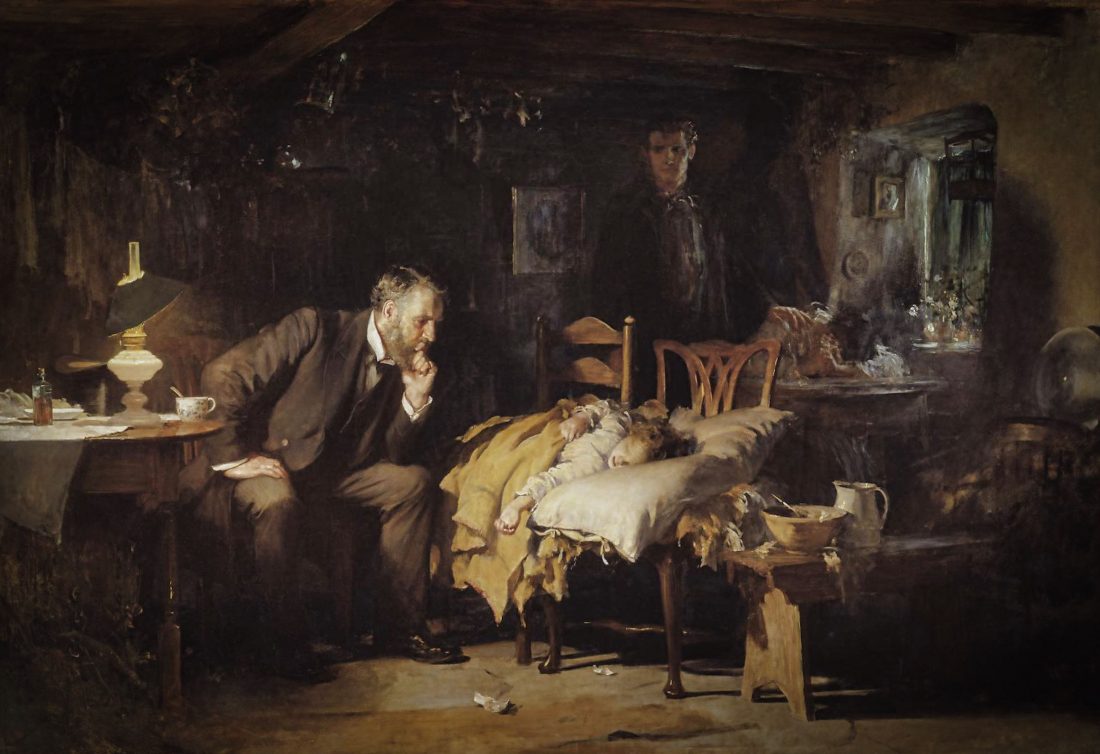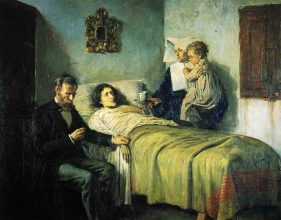Share Post
What happens when we compare our insides with others’ outsides?
What do you see when you look at this picture? A waxen faced child; a seated man, deep in thought; a seated woman, lost in shadow, and grief; and a standing man, his steadying hand on the woman’s shoulder, but whose face displays…what?
A picture can tell many stories.
The typical doctor as we would all like him to be shown – an honest man and a gentle man, doing his best to relieve suffering
W. Mitchell Banks
Luke Fildes painted this picture in 1891; he wanted to ‘put on record the status of the doctor in our own time’. He based the scene in a fisherman’s cottage in Hope Cove, in South Devon—not far from where I live—and had a replica of the room built in his studio in London. He may have been inspired by the doctor who attended his own son, who died from typhoid on Christmas day, a decade before.
Many people see in this picture the archetypal story of the good doctor. This is not a brief home visit but a whole night, watching and ministering to the little girl, a steadfast reassurance to her family. Through the dark, small hours his bulk has not shifted from the uncomfortable chair, except perhaps to spoon medicine between her tremulous lips. He has eyes only for his patient, the centre of his world, adjusting the sole light so that he can monitor her every breath.
The painting resonates because all viewers. . .desire to be cared for with [that] kind of single-minded attentiveness
Abraham Verghese
His thoughts have not wavered, and his steely resolution in itself is almost enough to keep her alive. Perhaps she has lobar pneumonia, the classic, pre-antibiotic Hollywood illness, where high fever develops into a near death crisis, sometimes followed by a miraculous recovery. Here, the morning light is breaking through the window as a sign of her returning health. The mother’s prayers have been answered and the father’s trust has been rewarded.
Over the years the painting has been called upon to illustrate many aspects of superlative clinical practice. But when I look at this picture I see a different story. Perhaps it’s because I’m looking from the inside, from the experience of sitting impotently at a patient’s bedside while their life slips away. When I look at the doctor’s eyes I see an inner turmoil of doubt and uncertainty: “What have I missed? What else could I have done..?”
At his feet are his failed prescriptions, crumpled and torn. His futile attempts at remedy are pushed aside on the table, utterly useless. The focused beam of light exacerbates his terrible, inescapable, tunnel vision. His weary shoulders droop under the weight of the mother’s grief, and the father’s accusing stare. The cold light of dawn frames the emerging reality that he will live with in the days and years ahead.
His manner is all, and Fildes captures it forever: the furrowed brow; the hand propping the firm bearded chin; the calm, concerned authority
Colin Douglas
Erving Goffman writes about the way that we all present a front to the world, so that others see us differently from how we see ourselves from the inside. This personal front includes our appearance and our manner, and will vary in different circumstances. When I’m seeing a patient in my clinic the front that I present is different from when I’m with my family. It’s not that I’m pretending to be a different person, but certain aspects of professionalism are expected by patients, by colleagues and by myself. In fact, I feel the need to project different aspects of my self in the varied parts of my professional role: exploring a sensitive aspect of a patient’s illness in clinic demands a different front from that needed when leading an airway emergency in the operating theatre.
Goffman talks about how we present an idealised version of ourselves, playing up certain aspects, such as trustworthiness, and playing down others: fallibility, effort, compromise, the tricks of the trade. He mentions the ways that doctors try to give the patient a sense of uniqueness and centrality, finding systems to recall telling details from the patient’s life, even when their own memory does not allow this.
This sounds a bit like dishonesty, but Goffman questions whether others can ever see the reality of who we are. In his animated documentary, Ryan, Chris Landreth vividly, and viscerally, portrays how our inner selves might appear without this shielding shell.
The front we present always lies somewhere between cynicism and sincerity, and rarely at either extreme. Furthermore, others expect a certain portrayal of our part in order to believe in us. My play, True Cut, explores what happens when things go wrong in clinical practice, the effects on the patient but also the impact on clinicians. During post-performance discussions a common theme is that many members of the public want to be able to continue to believe in the perfect doctor, focused entirely on their needs as a patient, and incapable of mistakes.
That doctor does not exist.
To the degree that the individual maintains a show before others that he himself does not believe, he can come to experience a special kind of alienation from self and a special kind of wariness of others
Erving Goffman
But over time there is a tendency for us to internalise the mask that we are portraying, the expectations of our patients and colleagues, and our own assumptions of perfection. This creates a continuous dissonance with the view we get from the inside, with the person we know we are, with the reality of being human. Inevitably, there are times when our understanding, our actions or our thoughts do not measure up to the ideal. Unchecked, this dissonance can lead to feelings of inadequacy, cynicism and emotional overload. What makes this more difficult, is the feeling that we are in this alone: that everyone else has it all together; that it’s only me that experiences doubt and uncertainty, and does stupid things from time to time.
Staff who regularly attend Schwartz Rounds feel less stressed and isolated at work. Listening to colleagues describe the challenges of their work helps to normalise emotions, which are part and parcel of working in healthcare but are often kept under the surface.
Point of Care Foundation
At my hospital I act as clinical lead for Schwartz Rounds. These provide one of the few opportunities—for clinical and non-clinical staff—to start to share these inner views, in a forum that is safe, confidential and non-judgemental. Invited panel members talk about an experience, with the focus on their inner view of events: how they were affected by what happened. The audience is encouraged to respond by sharing the ways that these stories resonate with their own experiences. Those who attend gain an insight into the inner lives of other staff, provide mutual support and begin to develop a shared understanding of our common humanity. The Rounds provide one important route to move away from the isolating effect of comparing our inner view with the outer fronts we see from others.




